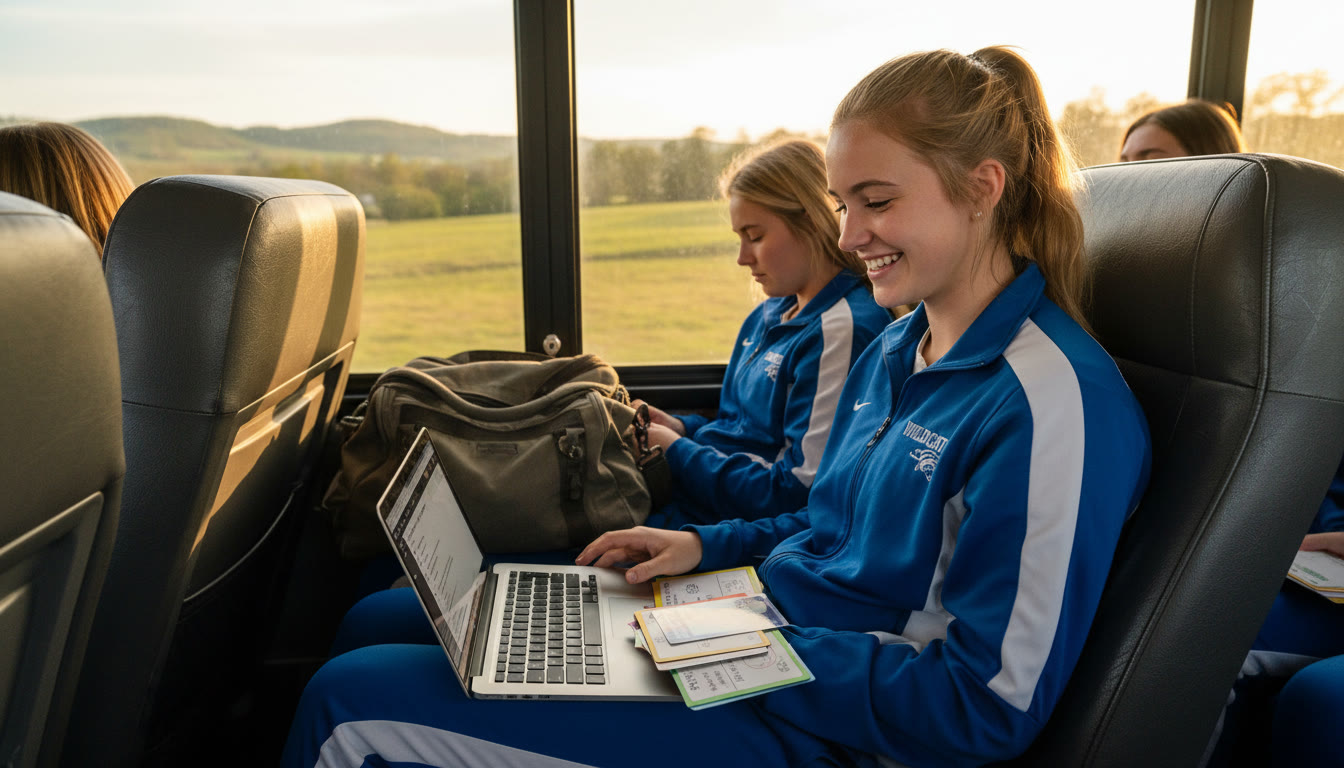Why this matters: The athlete’s tightrope between APs and the season
If you’re an NCAA-bound athlete, you know the calendar is full — early-morning lifts, practice, film sessions, travel, and yes: class. Toss on Advanced Placement (AP) courses and the balancing act becomes more than juggling; it becomes an art. This blog is written for student-athletes and their families who want to pursue rigorous academics (APs), perform at a high level in sport, and keep college admissions doors wide open.
We’ll walk through how to choose a sustainable AP load, when to take lighter or heavier semesters, how to protect recruiting and competition windows, and practical tools — including tailored tutoring and planning options like Sparkl’s personalized support — to keep both your GPA and performance upward.
Big-picture principles before you pick classes
Start with four principles that make all other decisions easier.
- Prioritize health and consistency: Sleep, injury prevention, and mental health are not optional. A high AP load that causes chronic sleep deprivation is a bad trade-off.
- Think in seasons, not semesters: Sports have peaks (season, showcases, playoffs) and valleys (offseason, light travel). Match AP intensity to your sports calendar.
- Quality over quantity: Admissions committees prefer depth and excellence in a realistic program over overreaching and underperforming.
- Communicate early and often: Coaches, counselors, AP teachers, and parents should be part of planning so adjustments can be made quickly when conflicts arise.
How APs factor into college admissions for athletes
Colleges evaluate academic rigor, grades, standardized test performance (when applicable), and athletic potential. AP courses signal you’re ready for college-level work; strong AP scores and A’s in AP classes are persuasive. But remember: athletic recruiting hinges on performance, availability, and development. Admissions committees want to see that you can handle both — and you don’t have to max out APs to prove it.
Map your year: Align AP load to your sports calendar
Design your academic plan around the demands of your sport. Use the following seasonal framework and then customize it to your specific timelines — e.g., midseason tournaments, national showcases, or fall playoffs.
Fall sport example (e.g., football, soccer, cross-country)
- Heavy commitment: August–November (season). Practices daily, high travel for some teams.
- AP strategy: Aim for 1–2 rigorous APs in the fall and reserve heavier APs for spring. If you’re taking APs both semesters, choose one AP that’s project-heavy or exam-timed in spring, and one that’s concept-driven in fall.
Winter sport example (e.g., basketball, wrestling, swimming)
- Heavy commitment: November–March.
- AP strategy: Consider taking your most demanding APs in the semester that has less game travel. Use winter breaks as intensive study blocks. If you’re a senior with recruiting meetings, lighten your fall AP load to stay sharp for winter performance.
Spring sport example (e.g., baseball, lacrosse, track)
- Heavy commitment: February–May.
- AP strategy: Avoid stacking multiple AP exams in May with major sporting events. Push some APs to fall or take fewer AP exams the spring you have high-stakes meets.
Sample course-load templates for common scenarios
Below are typical semester templates that balance rigor with athletic demands. Use them as starting points and adapt to your school’s offerings and NCAA eligibility timeline.
| Profile | Fall Semester | Spring Semester | Why this works |
|---|---|---|---|
| Varsity starter, heavy travel (junior) | 1 AP (core) + 2 Honors + 1 Elective | 2 APs (one STEM, one humanities) + 1 Elective | Light fall AP load preserves game prep; spring heavier APs when travel lessens. |
| Two-sport athlete (senior) | 1 AP + 3 Regular | 1 AP + 3 Regular | Maintains GPA while minimizing burnout during dual seasons. |
| Offseason focus on recruiting (sophomore) | 2 APs (one project-based) + 2 Regular | 2 APs + 1 Elective | Balanced rigor to build transcript strength while off-season allows study time. |
| Academic focus, club sport (junior) | 3 APs + 1 Elective | 3 APs + 1 Elective | Club sport less demanding—opportunity for heavier AP load across both semesters. |
How to use this table
Pick the profile closest to your situation and then modify by shifting an AP from the heavier season to the lighter one, or by replacing an AP with an honors course if you need to protect practice time.
Weekly time-budget: realistic study planning for AP success
Quantify the commitment. AP courses vary in workload, but here’s a conservative weekly breakdown to help schedule your weeks during the season.
- AP Lecture or Class Time: 4–6 hours (in-school)
- Homework and Reading: 4–8 hours per AP
- Practice/Training: 10–20+ hours depending on sport and season
- Recovery and Sleep: 7–10 hours nightly recommended
So, for two AP classes during season you’re realistically committing 10–20 hours outside class (plus in-class and athletic time). That’s why schedule tailoring is essential: shaving one hour of unproductive screen time, shifting a study block to travel drives, or using strategic tutoring can bridge the gap between overwhelm and mastery.
Smart study techniques that save time and improve retention
Not all study time is equal. Use these high-impact techniques to get the most learning per hour.
- Active recall: Practice retrieval rather than passive rereading — flashcards, self-quizzing, and practice FRQs.
- Interleaving: Mix problem types or subjects in one study session to improve transfer and retention.
- Spaced repetition: Schedule short reviews in the days leading up to big exams rather than cramming the night before.
- Exam simulation: Do timed practice sections under test-like conditions to build stamina and pacing.
- Microstudy bursts: Use 20–40 minute focused blocks when time is tight (travel time, pre-practice) and a single 90–120 minute review when possible.
Plug-and-play weekly template for in-season athletes
- Monday: Practice + 30–45 min AP review (active recall)
- Tuesday: Practice + 90-min targeted study (problem solving)
- Wednesday: Light practice + 45-min AP reading/notes
- Thursday: Practice + 90-min mixed subject practice (interleaving)
- Friday: Lighter practice or film + 30-min spaced repetition
- Weekend: One long study block (2–3 hours) plus review sessions during travel
Navigating AP exam timing and conflicts with competitions
AP Exams generally occur in May, often overlapping with spring championships and late-season events. If you have a high-stakes athletic commitment in May, consider:
- Taking alternative APs in fall/earlier semesters so your heaviest exams aren’t concentrated in May.
- Communicating early with your AP coordinator to understand make-up exam policies and late-testing windows.
- Using targeted tutoring sessions in late April for final review; short, high-quality sessions beat marathon cramming when travel is involved.
How to decide which APs to take: a decision rubric
Use a simple scoring system — Rate each AP you’re considering on these four criteria: Interest (I), Academic Benefit (A), Time Demand (T), and College Relevance (C). Score each 1–5 and prioritize courses with high combined scores and manageable time demands.
- Interest: Will you stay engaged? (Higher interest = more sustainable.)
- Academic Benefit: Does the AP strengthen your transcript for your intended major? (AP Calculus for engineers, AP Biology for pre-med, etc.)
- Time Demand: Some APs are writing or project heavy (AP Research, AP Art) or problem-dense (AP Physics C). Be realistic.
- College Relevance: Do likely colleges want this AP on your transcript? (Check typical pre-major expectations.)
Real-world examples and trade-offs
Example 1: A junior pitcher with spring showcases. If the pitcher is traveling heavily in April–June for scouting and combines, stacking AP Calculus AB and AP US History (both heavy in different ways) in spring could be risky. A better plan: take AP Calculus in fall (with sustained weekly study) and AP US History in the following fall or as a lighter honors option.
Example 2: A senior basketball guard with recruiting interviews in winter. Lighten your fall APs to preserve mental focus heading into the winter. Use winter break for SAT/ACT (if applicable) and final AP study sessions. If you have to choose between an extra AP and consistent varsity minutes that will improve recruiting, the latter often makes sense — but compensate by taking a rigorous senior-year curriculum where possible without burning out.
How parents and coaches can help (without micromanaging)
- Encourage routine: Help create a stable schedule that prioritizes sleep and recovery.
- Be an accountability partner: Check in weekly about workload and stress, not just grades.
- Coordinate with school staff: Encourage early conversations between AP teachers, the athletic trainer, and counselors to plan around showcases and exams.
- Support outside help: Consider targeted tutoring or time-management coaching when schedules tighten.
How personalized support like Sparkl fits into an athlete’s plan
Personalized tutoring can be a game-changer for athletes who need high-leverage solutions. Services that offer 1-on-1 guidance, tailored study plans, expert tutors, and AI-driven insights can compress learning time and focus practice on the skills that matter most. For example, a short series of targeted Sparkl sessions before a major AP exam can help you focus on weak concepts, develop pacing strategies for free-response questions, and build confidence — all while preserving time for training and recovery.
Use tutoring selectively: schedule bursts around exam windows, project deadlines, or when you’re changing seasons. The best tutors translate your athletic calendar into a study calendar that respects travel and fatigue.
Accommodations and special testing situations
If an athletic event forces you to miss an AP exam date, schools have procedures for late testing. Speak to your AP coordinator as soon as you know there’s a conflict. Documentation from coaches and travel schedules can help request alternate arrangements. Plan early: the more advance notice you provide, the easier it is for schools to accommodate late exams or alternate dates.
Checklist: End-of-semester and pre-exam to-dos
- Confirm AP exam registration and dates in My AP and with your AP coordinator.
- Map major competitions, showcases, or recruiting events against exam dates.
- Create a 6-week revision plan using active recall and practice exams; block times on your calendar like training sessions.
- Schedule 1–2 tutoring sessions for targeted review (e.g., FRQ strategies, problem sets) in the two weeks before the exam.
- Prioritize sleep and nutrition for two weeks before both important competitions and exams—your brain and body need fuel.
Measuring success: What to track beyond test scores
Beyond AP scores and GPAs, track these signals to ensure long-term success:
- Consistency of practice attendance and minutes played (availability matters to recruiters).
- Academic momentum: Are grades stable or improving across challenging courses?
- Wellness metrics: Sleep hours, injury frequency, stress levels.
- Coach and teacher feedback: Are both noticing growth in performance and focus?
Final thoughts: Sustainable ambition beats burnout
Athletes who thrive balance ambition with sustainability. AP courses are powerful tools to demonstrate college readiness, but they’re most effective when chosen and scheduled intelligently around the realities of competitive sport. Start early, be honest about time costs, and use high-impact study strategies. When things get tight, lean on targeted supports — a short, intensive tutoring run or a tailored Sparkl plan can preserve both your athletic edge and academic ambitions.
At the end of the day, colleges want resilient, team-oriented students who can handle pressure and continue growing. When you learn to plan well, communicate with your support network, and prioritize recovery, you’ll stand out not just as an athlete or a scholar, but as a person who knows how to manage responsibilities — and that’s exactly the kind of student coaches and admissions officers love to recruit.


Quick action plan: Next 30 days for athletes choosing APs
- Week 1: Meet with your counselor, list desired APs, and map your sports calendar for the year.
- Week 2: Score each AP with the Interest-Academic-Time-Relevance rubric and draft a semester map.
- Week 3: Talk to coaches and AP teachers about conflicts; seek compromises or alternate exam plans.
- Week 4: Finalize schedule and book targeted tutoring sessions for critical exam windows; set a weekly study routine and stick to it for two months.
One-sentence takeaway
Choose APs strategically, protect your health and playing time, use smart study techniques, and get targeted, personalized help when needed — that’s how student-athletes win in both classrooms and on the field.























No Comments
Leave a comment Cancel